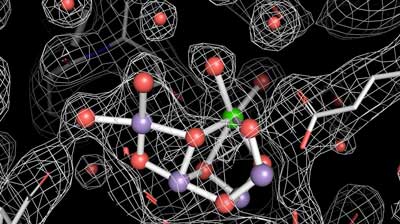| Feb 13, 2019 | |
Atomic snapshots of photosynthesis(Nanowerk News) Despite its role in shaping life as we know it, many aspects of photosynthesis remain a mystery. An international team is working to change that. They focused on a key protein complex called Photosystem II. |
|
| They captured the most complete and highest-resolution images to date of Photosystem II at work. The team’s pictures and movies show all four stable intermediate states of Photosystem II that produce the oxygen we breathe. Also, they caught fleeting steps in between. | |
| Their work (Nature, "Structures of the intermediates of Kok’s photosynthetic water oxidation clock") opens doors to creating artificial photosynthesis to produce energy from sunlight and water. | |
 |
|
| New pictures of Photosystem II show different ways the protein complex shifts and stretches as it splits water. This image shows the water-oxidizing complex in the last stable state before the water splits. (Image: Jan Kern, Lawrence Berkeley National Laboratory) | |
| Photosynthesis is how plants, algae, and certain bacteria use sunlight to make sugars and other energy-rich compounds that they need to survive and grow. During photosynthesis, the sunlight is used to extract electrons from water, splitting the water into oxygen and hydrogen in the process. Creating similar systems could lead to clean, renewable energy from sunlight and water. | |
| Knowing how a key protein complex in photosynthesis, Photosystem II, works is key to designing such system. This research offers an unprecedented view of how the protein complex shifts and stretches during water splitting. Such detailed snapshots unlock the doors to cleaner energy. | |
| More than 2 billion years ago, tiny organisms on Earth started photosynthesizing. Nearly all life on Earth now depends on photosynthesis but it’s not understood in detail. Scientists want to understand the nuances of the process and use those insights to design systems that use sunlight and water to produce fuel. | |
| The challenge is that the process is incredibly complex and certain steps happen quickly at the scale of individual atoms. | |
| Now, a team from the United States, Germany, Sweden, and the United Kingdom has obtained detailed pictures and movies of a key aspect of photosynthesis. In particular, they focused on the workhorse protein complex, called Photosystem II. | |
| They saw how it stretched and shifted, breaking and making metal oxygen bonds, during four of the five reaction states involved in breaking water apart. They obtained the images using SLAC’s Linac Coherent Light Source X-ray laser with serial femtosecond X-ray crystallography and simultaneous X-ray emission spectroscopy. | |
| The resolution of the images is 2 angstroms at room temperature. Previous techniques offered a slightly less detailed view and required cooler conditions. With this more detailed view, the researchers saw lighter atoms, such as oxygen, in addition to the metal atoms in the catalytic center, and better described the area inside Photosystem II where water splitting occurs. They also observed two transient moments between reaction states. | |
| The results will help clarify how water binds to the complex and how oxygen forms. The results are a key part of efforts to offer new insights for renewable energy. |
| Source: U.S. Department of Energy, Office of Science | |
|
Subscribe to a free copy of one of our daily Nanowerk Newsletter Email Digests with a compilation of all of the day's news. |
